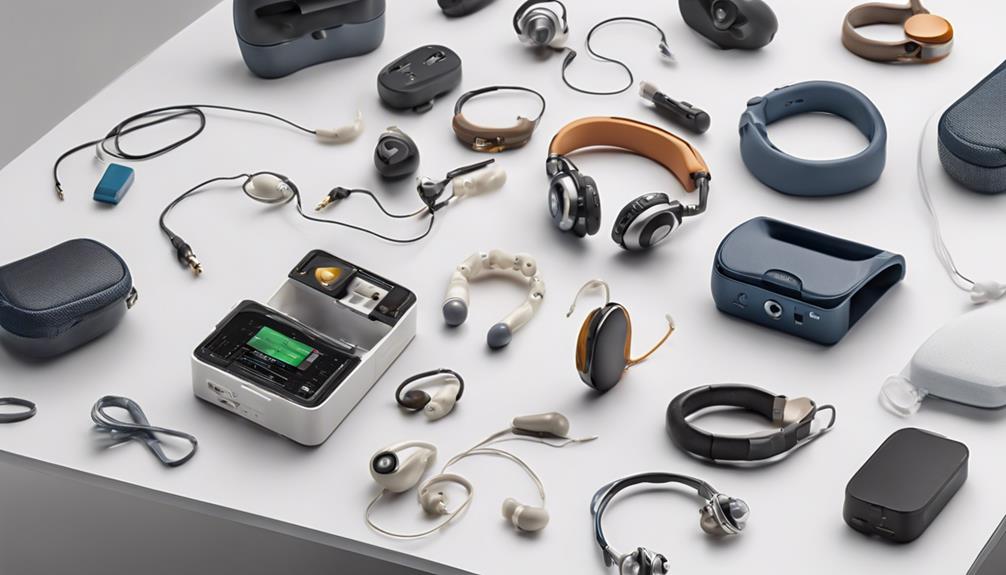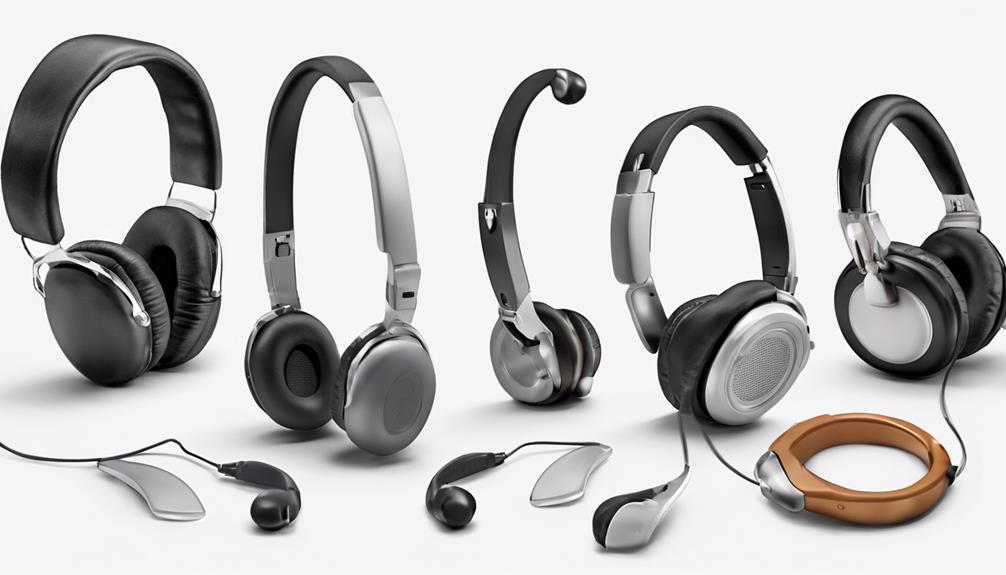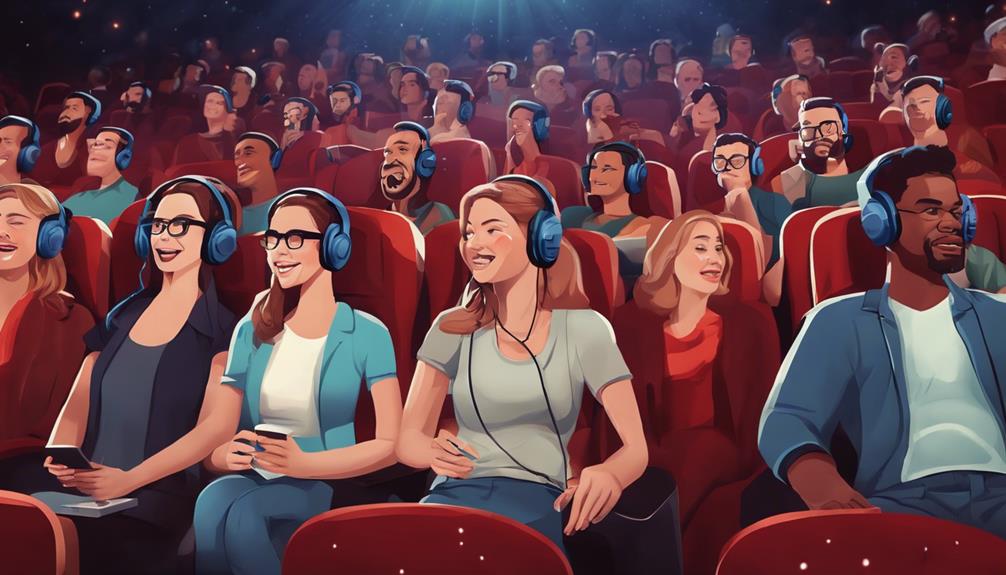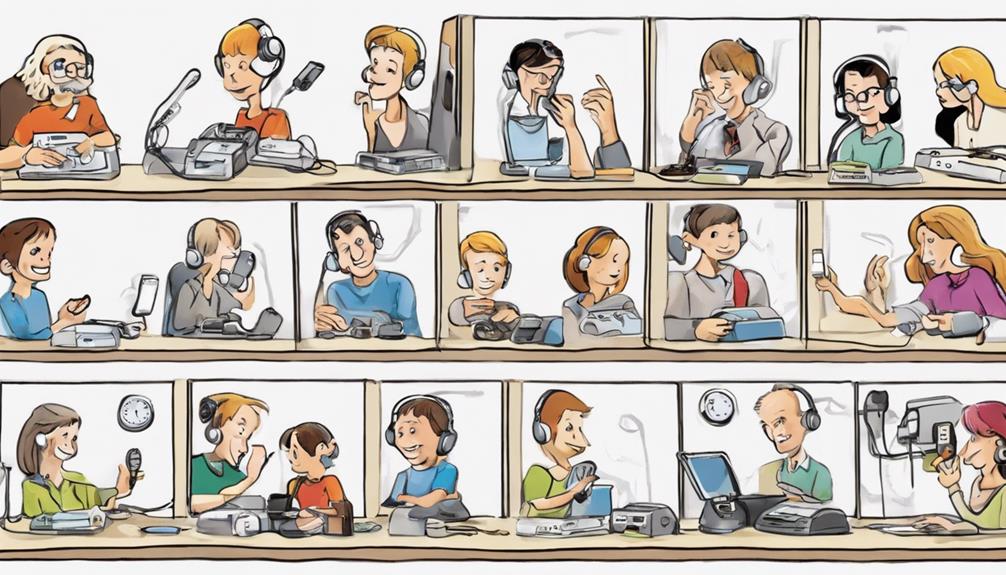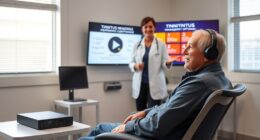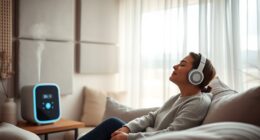Have you ever considered how hearing aids could transform your auditory experience?
From specialized alarm clocks to innovative communication tools, the realm of assistive listening devices offers a multitude of solutions to enhance your listening experience.
With a range of devices tailored to different needs, exploring the top 7 options could provide valuable insights into improving your auditory environment.
Key Takeaways
- Hearing amplifiers enhance listening clarity and volume for mild to moderate hearing loss.
- Wireless connectivity devices like Bluetooth headphones offer noise cancellation and compatibility with various devices.
- Adjustable volume control devices provide up to 120dB of amplification for a personalized listening experience.
- Visual alert devices incorporate bright lights and LED displays to convey messages clearly for individuals with hearing difficulties.
Hearing Amplifiers
Hearing amplifiers are essential personal sound devices that enhance listening clarity and volume for individuals with hearing difficulties. These devices offer adjustable volume control, allowing users to customize the sound amplification based on their specific needs.
With portable designs, they're convenient for use in various listening environments, whether at home, work, or on the go. The amplifiers provide up to 120dB sensitivity, ensuring that even individuals with mild to moderate hearing loss can benefit from the amplified sound.
Bluetooth Headphones
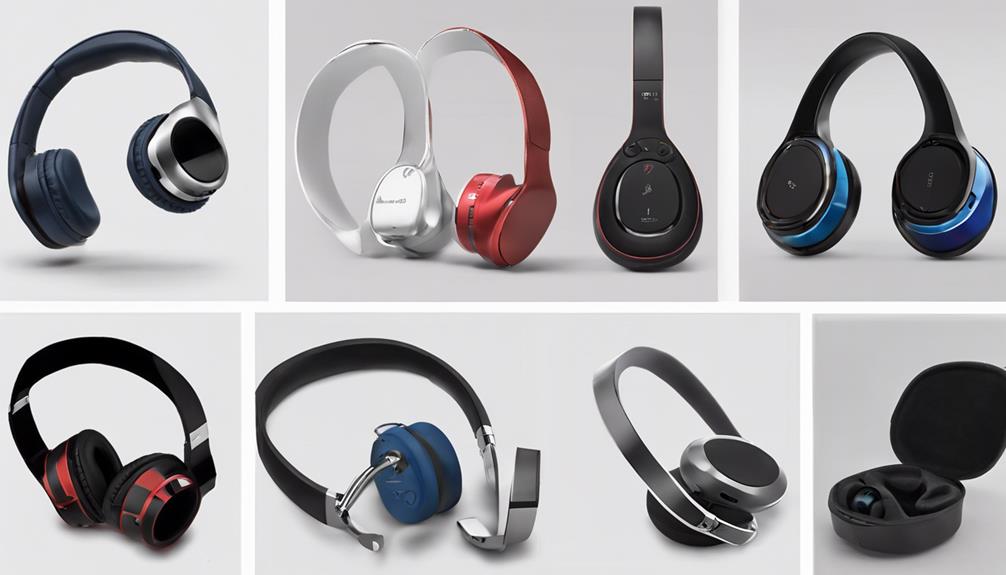
Enhancing the listening experience with wireless convenience and high-quality sound transmission, Bluetooth headphones are versatile devices compatible with a wide array of electronic gadgets. Here are some key features of Bluetooth headphones:
- Wireless Connectivity: Bluetooth headphones offer the freedom to move around without being tethered by cords, providing a seamless listening experience.
- High-Quality Audio: These headphones deliver crisp, clear sound with advanced audio technology and often include noise cancellation features for immersive listening.
- Compatible Devices: Bluetooth headphones can connect to various devices like smartphones, tablets, and laptops, making them a flexible choice for different usage scenarios.
- Long Battery Life and Quick Charging: Many Bluetooth headphones boast extended battery life for prolonged use, and quick charging capabilities ensure minimal downtime between listening sessions. Some models also come with a built-in microphone for hands-free calling and support voice assistants for added convenience.
Personal Sound Amplifiers
Personal sound amplifiers like the Williams Sound Pocketalker 2.0 excel in enhancing sound clarity with reduced background noise. They offer a comfortable and discreet design, making them suitable for everyday use in various settings.
These amplifiers feature adjustable volume control for personalized amplification levels, catering to different types of hearing impairments.
Sound Clarity Enhancement
Amplifying ambient sounds while minimizing background noise, sound clarity enhancement devices provide users with a heightened auditory experience. When considering personal sound amplifiers for sound clarity enhancement, it's essential to focus on specific features that enhance the listening experience:
- Superior Sound Quality: Devices like the Williams Sound Pocketalker 2.0 reduce background noise, improving the clarity of conversations and environmental sounds.
- Enhanced Gain: The Reizen Loud Ear Hearing Enhancer offers up to 110dB gain, catering to individuals with varying degrees of hearing loss.
- Portability: These devices are portable and convenient, easily attaching to clothing for on-the-go use.
- Customized Experience: Equipped with microphones and adjustable volume controls, personal sound amplifiers provide personalized sound enhancement for better communication and interaction.
Comfortable and Discreet
Comfortably designed and discreetly crafted, personal sound amplifiers offer users a seamless listening experience in various settings. These assistive listening systems, such as the Williams Sound Pocketalker 2.0, feature ergonomic designs for comfort during extended use.
Lightweight and portable amplifiers like the Reizen Loud Ear Hearing Enhancer provide up to 110dB gain, enhancing listening experiences significantly. Their discreet nature allows for easy attachment to clothing, ensuring accessibility on the go.
Personal sound amplifiers excel in reducing background noise, resulting in clearer sound quality and improved listening experiences overall. With these devices, users can enjoy enhanced sound clarity without compromising on comfort or style.
Adjustable Volume Control
Featuring intuitive controls for adjusting volume levels, personal sound amplifiers cater to individual hearing preferences, enhancing sound clarity for improved listening experiences.
These devices offer adjustable volume control for customized listening, providing up to 120dB of amplification to compensate for hearing loss. Users can fine-tune the volume to suit their specific needs, resulting in enhanced sound understanding.
Lightweight and portable, personal sound amplifiers are suitable for various settings, ensuring amplified sound wherever you go. Equipped with built-in microphones and dual earphones, these devices allow for a personalized listening experience tailored to individual preferences.
TV Listening Devices
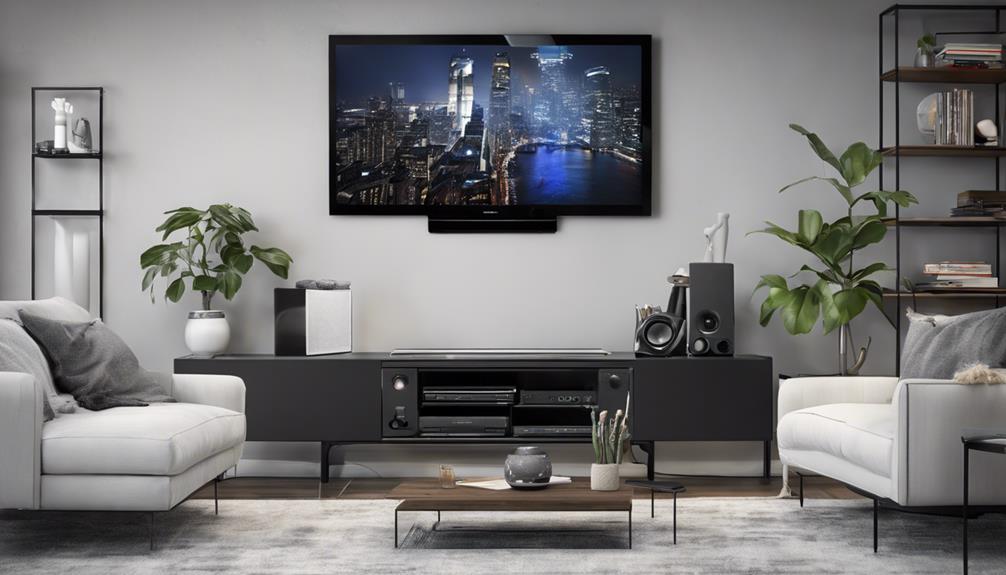
TV listening devices revolutionize the audio experience for individuals with hearing impairments, ensuring crisp and immersive sound without disturbing others. These TV assistive devices, such as TV Ears wireless headsets and TV amplifiers, amplify audio to enhance sound quality, providing a customized listening experience. With advanced TV listening technology, users can adjust sound levels to their preference, creating an immersive television experience.
| TV Listening Devices | Features |
|---|---|
| TV Ears | Clear TV sound |
| TV amplifiers | Enhanced sound quality |
| TV listening technology | Customizable sound levels |
| TV assistive devices | Immersive TV experience |
These devices offer a range of benefits, from clear TV sound for better comprehension to customizable features that cater to individual hearing needs. By utilizing TV listening devices, users can enjoy their favorite shows and movies with improved audio quality, making their TV watching experience more enjoyable and inclusive.
Alerting Systems
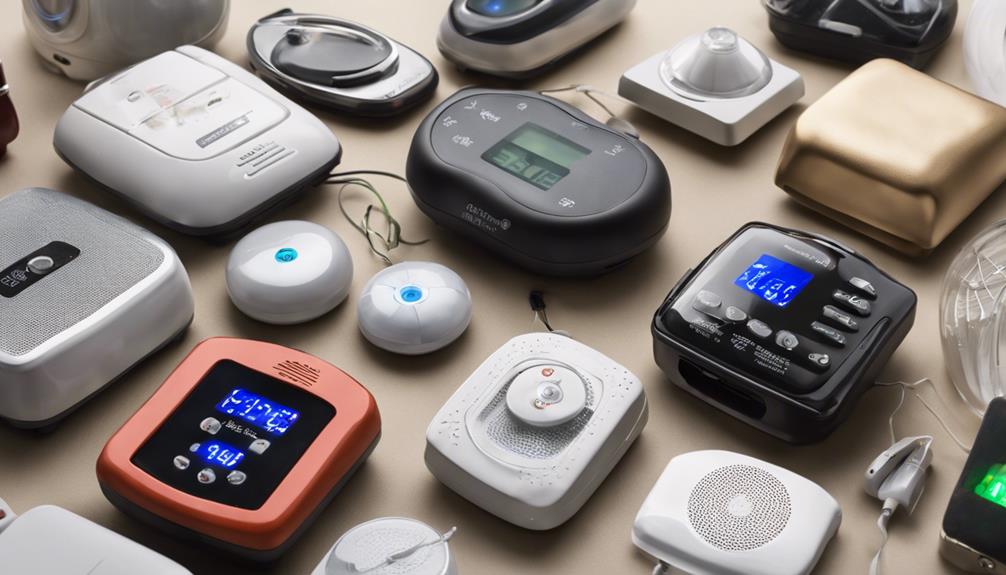
Alerting systems utilize cutting-edge technologies like Sound Signal Technology to provide auditory and visual alerts for individuals with hearing impairments. Visual Alert Devices, such as flashing lights and vibrating alarms, ensure that users are promptly notified of safety concerns.
Wireless Notification Systems, like the Sonic Alert HomeAware Fire and CO Signaler, play a vital role in enhancing safety through timely alerts and notifications.
Sound Signal Technology
Utilizing advanced sound signal technology, alerting systems play a crucial role in providing notifications to individuals with hearing loss through a combination of flashing lights, vibrations, and loud alarms. These systems ensure timely alerts for emergency notifications and enhance visitors' awareness.
Some key points to consider about alerting systems are:
- The Sonic Alert HomeAware Fire and CO Signaler offer safety features like strobe lights and bed shakers.
- Devices such as the Sonic Alert vibrating alarm clock utilize bright lights and loud auditory signals for effective alerts.
- Doorbell notification systems, like the WP180USL Wireless Doorbell, increase awareness of visitors through lights or vibrations.
- Alerting systems are essential for individuals with hearing loss to stay informed and safe in various situations.
Visual Alert Devices
In environments where auditory signals may not be effective, visual alert devices play a crucial role in notifying individuals with hearing loss of important sounds or alarms using flashing lights. These visual alert systems, also known as alerting systems, are essential for providing safety alerts like fire alarms, doorbells, and phone calls through visual cues. They're particularly effective in situations where auditory signals may be missed, ensuring timely awareness for individuals.
Incorporating features such as bright lights, strobe lights, and LED displays, visual alert devices grab attention and convey messages clearly. By enhancing accessibility and communication for individuals with hearing difficulties, visual alert devices significantly contribute to improving overall safety and quality of life.
Wireless Notification Systems
Wireless notification systems, with their visual and vibration alerts, play a critical role in enhancing safety and awareness for individuals with hearing loss. These systems ensure that users are promptly notified about alarms, doorbells, and other important alerts through features like flashing lights, vibrating alerts, and loud alarms.
They're essential for individuals with hearing difficulties to stay informed and respond effectively to various alerts, contributing significantly to their safety and well-being. Wireless notification systems provide crucial support in different environments, offering a reliable means of communication that's tailored to the needs of those with hearing impairments.
Hearing Aid Accessories
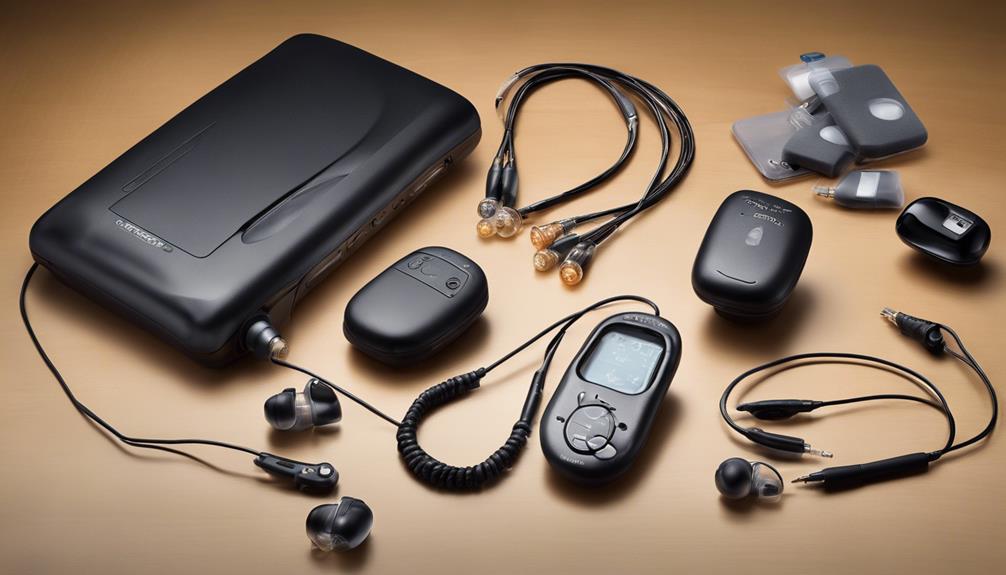
Maintaining hearing aid performance and longevity involves utilizing accessories like cleaning tools and drying containers. These essential items help keep your devices in optimal condition, ensuring they function effectively.
Remote controls play a crucial role in making adjustments to volume, program settings, and other features hassle-free, without the need for manual tweaks. Bluetooth accessories offer seamless wireless connectivity, allowing you to connect your hearing aids to various devices such as smartphones, TVs, and audio systems, providing enhanced listening experiences.
When it comes to power, hearing aid batteries come in different sizes, including rechargeable options for cost-effectiveness and eco-friendliness. Additionally, using dehumidifiers can help remove moisture from your devices, safeguarding them from damage and preserving their performance for improved hearing outcomes.
These accessories not only enhance the functionality of your hearing aids but also contribute to a better overall listening experience through convenient adjustments and optimized maintenance.
Assistive Listening Apps
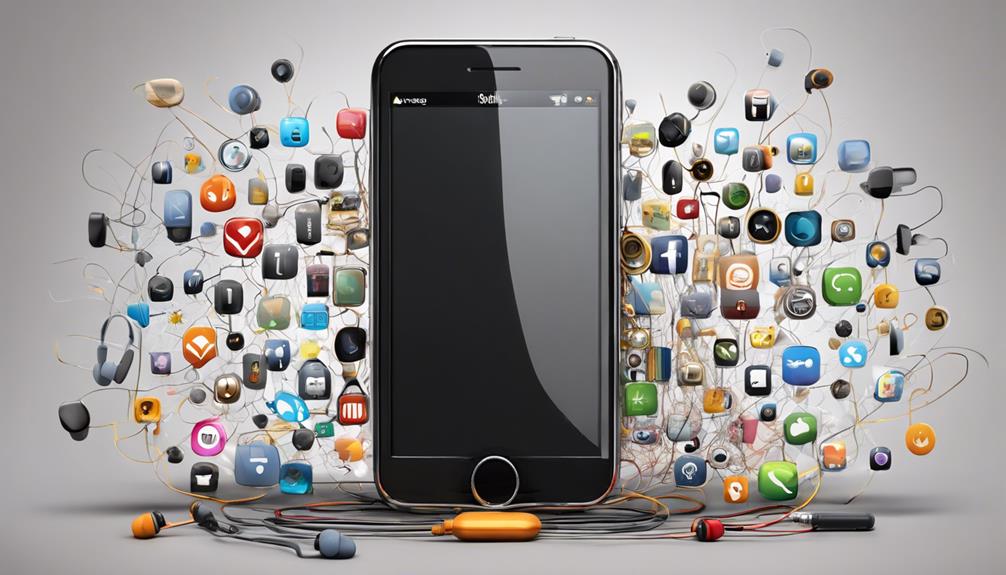
To enhance the functionality of hearing aids further, let's explore the realm of Assistive Listening Apps, which offer personalized sound amplification and advanced features for improved listening experiences.
Assistive listening apps can provide tailored sound amplification directly on smartphones, enhancing the clarity and volume of incoming audio. These apps come equipped with features such as speech enhancement, background noise reduction, and real-time volume adjustments, ensuring optimal audio clarity in various listening environments.
Leveraging Bluetooth technology, some assistive listening apps seamlessly connect with compatible hearing aids or headphones, allowing for a convenient and personalized listening experience. Users can benefit from the ability to make precise audio balance adjustments, ultimately contributing to an enhanced overall listening experience.
Assistive listening apps serve as valuable tools for individuals seeking to optimize their auditory capabilities and enjoy improved sound quality in everyday situations.
Frequently Asked Questions
What Is the Most Commonly Used Assistive Listening Device?
The most commonly used assistive listening device is the hearing aid. It amplifies sound for individuals with hearing loss and comes in various styles like behind-the-ear (BTE), in-the-ear (ITE), and in-the-canal (ITC).
These devices can be customized for optimal performance based on individual preferences. Over 15% of American adults experience some degree of hearing loss, making hearing aids a popular choice recommended by audiologists and healthcare professionals for improved hearing clarity and quality of life.
What Devices Help You Hear Better?
When it comes to hearing better, we rely on a range of devices tailored to our needs. From hearing aids that amplify sounds to personal amplifiers like the Williams Sound Pocketalker 2.0 that reduce background noise, each device plays a crucial role in improving our listening experience.
Amplified phones, portable phone amplifiers, and hearing loop systems also contribute to clearer communication and enhanced sound transmission. These tools are essential for individuals seeking improved auditory clarity.
What Is the Best Device for Auditory Processing Disorder?
We find that the best device for Auditory Processing Disorder is a personal FM system, such as the Phonak Roger Pen. These systems utilize wireless technology to stream sound directly to the ears, reducing background noise and enhancing speech clarity.
Studies demonstrate the significant benefits of FM systems for individuals with Auditory Processing Disorder, improving speech comprehension and focus.
The Phonak Roger Pen stands out for its portability, versatility, and effectiveness in various listening environments.
Which Tool Is Designed to Improve Accessibility for People Who Are Hard of Hearing?
When we consider tools designed to improve accessibility for those hard of hearing, Hearing Loop Technology stands out as a game-changer.
By utilizing magnetic induction loops to create an electromagnetic field, this technology wirelessly connects directly to hearing aids, enhancing sound clarity in various environments.
Essential for individuals with hearing loss, hearing loops can significantly improve auditory experiences in places like airports and ticket windows.
Conclusion
In conclusion, these top 7 assistive listening devices serve as beacons of hope and connection for those facing hearing challenges.
Like a lighthouse guiding ships safely to shore, these innovative tools illuminate the path to clear communication and enhanced auditory experiences.
By embracing technology and specialized devices, individuals can navigate the seas of sound with confidence and ease, ensuring they never miss a moment of connection and communication in their daily lives.

